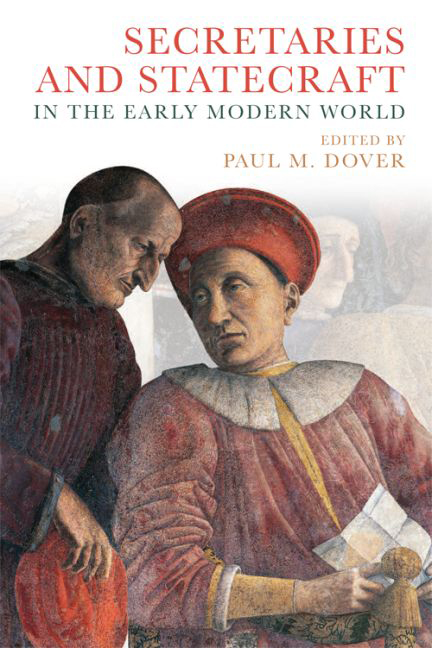Book contents
- Frontmatter
- Contents
- List of Contributors
- 1 Introduction: The Age of Secretaries
- 2 Records, Politics and Diplomacy: Secretaries and Chanceries in Renaissance Italy (1350–c. 1520)
- 3 Mercurino di Gattinara (1465–1530): Imperial Chancellor, Strategist of Empire
- 4 ‘This continuous writing’: The Paper Chancellery of Bernhard Cles
- 5 Parables and Dark Sentences: The Correspondence of Sir William Cecil and William Maitland (1559–73)
- 6 Axel Oxenstierna and Swedish Diplomacy in the Seventeenth Century
- 7 Statecraft and the Role of the Diplomat in Ducal Savoy: The Career of Alessandro Scaglia (1592–1641)
- 8 Richelieu, Mazarin and Italy (1635–59): Statesmanship in Context
- 9 The Learned Ideal of the Mughal Wazīr: The Life and Intellectual World of Prime Minister Afzal Khan Shirazi (d. 1639)
- 10 Reconsidering State and Constituency in Seventeenth-Century Safavid Iran: The Wax and Wane of the Munshi
- 11 Choreographers of Power: Grigorii Kotoshikhin, State Secretaries and the Muscovite Royal Wedding Ritual
- 12 Eberhard von Danckelman and Brandenburg's Foreign Policy (1688–97)
- 13 Chancellor of State: Prince Wenzel Anton Kaunitz, the Habsburg Foreign Office and Foreign Policy in the Era of Enlightened Absolutism
- Index
5 - Parables and Dark Sentences: The Correspondence of Sir William Cecil and William Maitland (1559–73)
Published online by Cambridge University Press: 21 November 2017
- Frontmatter
- Contents
- List of Contributors
- 1 Introduction: The Age of Secretaries
- 2 Records, Politics and Diplomacy: Secretaries and Chanceries in Renaissance Italy (1350–c. 1520)
- 3 Mercurino di Gattinara (1465–1530): Imperial Chancellor, Strategist of Empire
- 4 ‘This continuous writing’: The Paper Chancellery of Bernhard Cles
- 5 Parables and Dark Sentences: The Correspondence of Sir William Cecil and William Maitland (1559–73)
- 6 Axel Oxenstierna and Swedish Diplomacy in the Seventeenth Century
- 7 Statecraft and the Role of the Diplomat in Ducal Savoy: The Career of Alessandro Scaglia (1592–1641)
- 8 Richelieu, Mazarin and Italy (1635–59): Statesmanship in Context
- 9 The Learned Ideal of the Mughal Wazīr: The Life and Intellectual World of Prime Minister Afzal Khan Shirazi (d. 1639)
- 10 Reconsidering State and Constituency in Seventeenth-Century Safavid Iran: The Wax and Wane of the Munshi
- 11 Choreographers of Power: Grigorii Kotoshikhin, State Secretaries and the Muscovite Royal Wedding Ritual
- 12 Eberhard von Danckelman and Brandenburg's Foreign Policy (1688–97)
- 13 Chancellor of State: Prince Wenzel Anton Kaunitz, the Habsburg Foreign Office and Foreign Policy in the Era of Enlightened Absolutism
- Index
Summary
[N]ow I will merely co[m]playne off yow to yo[ur] selff. yow write alwayes to me parables at least bref and derk sentences and yow have experience off my simplicity […] I offer franknes on my p[ar]t and wishe yt by yo[ur] soueraygnes co[m]mandement at least p[er]mission I may fynd the counterpayne w[ith] yow.
Maitland to Cecil, 29 January 1562The relationship between Mary I of Scotland (1542–87) and Elizabeth I of England (1533–1603) was fraught with tension, suspicion and mutual distrust. Their personal misgivings had deep roots in the violence and antagonism that had characterised Anglo-Scottish relations for centuries, but also stemmed from more immediate religious and political anxieties. Like many of his predecessors, Henry VIII had a cunning plan to unite the two countries under one (English) crown, but just like other English kings who had ‘behaved like bulls in the Scottish china shop’, his attempts backfired. The Scots refused to deliver up their infant Queen Mary for marriage to Henry's own son Prince Edward, driving them further into the arms of their ‘Auld Alliance’ with France, which for centuries had worked as a check on English dominance of Britain. As a result, the six-year-old Mary was spirited away to the French court and betrothed to the Dauphin François, whom she married on 24 April 1558. As the grand-daughter of Margaret Tudor (Henry VIII's older sister), Mary also had a strong claim to the English throne, and following Mary Tudor's death without an heir on 17 November 1558, the French seized the opportunity to assert her rights and cast suspicion on the legitimacy of the proclaimed Protestant Queen Elizabeth. Mary even incorporated the English arms into her royal iconography, a threatening move that increased in significance after she became queen of France on 10 July 1559. However, to the relief of English Protestants, Mary's political position was transformed again when François died on 5 December 1560, and she was forced to return to her native Scotland in August 1561.
- Type
- Chapter
- Information
- Secretaries and Statecraft in the Early Modern World , pp. 90 - 114Publisher: Edinburgh University PressPrint publication year: 2016



